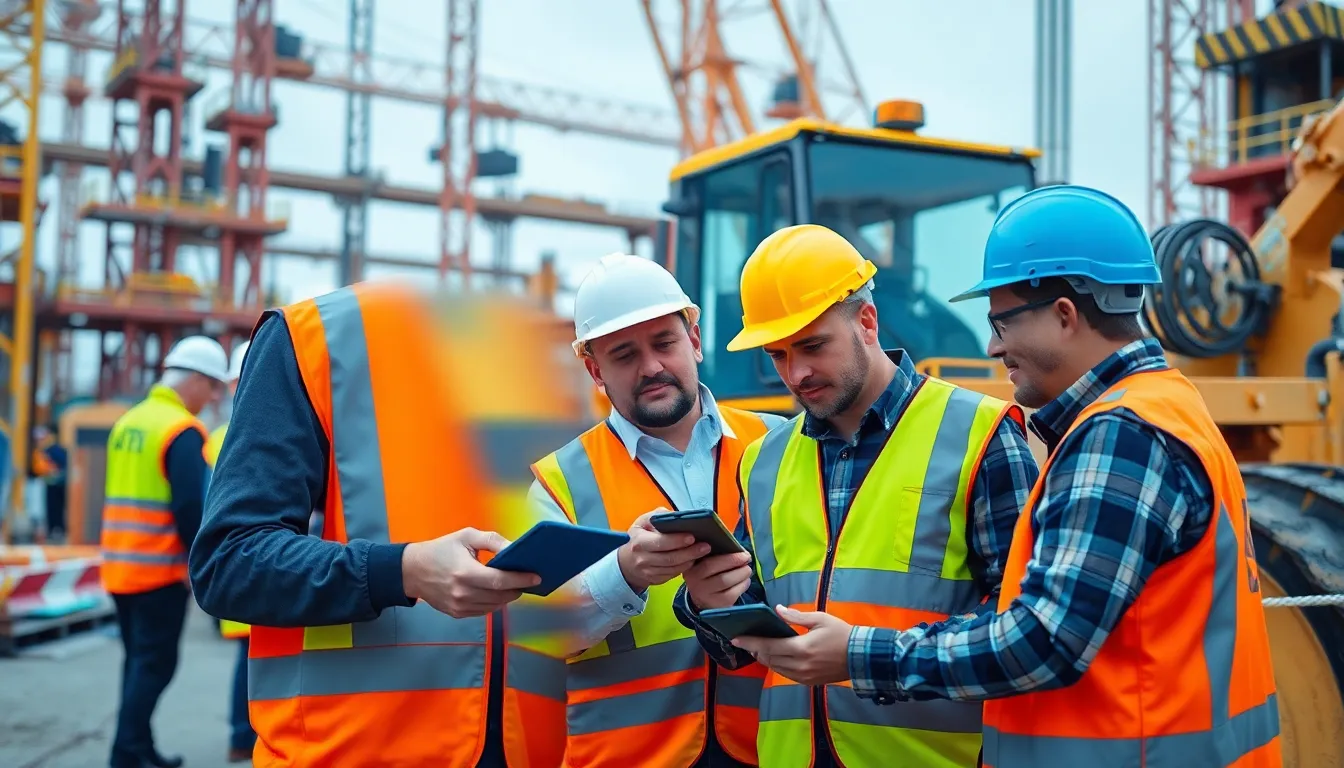The construction industry is known for its heavy machinery and hard hats, but it’s also stepping into the future with the Internet of Things (IoT). Imagine a world where your construction site is as connected as your smartphone—where tools can chat, materials can text, and safety equipment can send alerts faster than a foreman can say “measure twice, cut once.”
Table of Contents
ToggleOverview Of Internet Of Things In Construction Industry
The Internet of Things (IoT) revolutionizes the construction industry by creating interconnected environments. Connected devices streamline management, providing real-time data for smarter decision-making. Construction sites utilize sensors to monitor equipment health, reducing downtime.
Workers benefit from wearable devices that track their movements and monitor health indicators. These wearables can alert supervisors to potential hazards. Asset management improves through GPS and RFID tracking systems, ensuring tools and materials are readily available.
Data analytics plays a crucial role in optimizing construction processes. Analytics platforms process information from IoT devices, identifying patterns and inefficiencies. This leads to enhanced project planning and resource allocation.
Site monitoring enhances safety through surveillance systems integrated with IoT technology. Cameras equipped with AI capabilities detect intrusions or unsafe behaviors. Immediate alerts prompt timely interventions, promoting a safer work environment.
Energy consumption management gains importance with IoT solutions. Smart meters track energy usage on job sites, enabling adjustments that lower operational costs. Sustainable practices become more feasible as construction firms adopt these technologies.
Collaboration improves among stakeholders through shared IoT platforms. Project managers, contractors, and clients access real-time information to ensure transparency. This fosters better communication and accountability, streamlining workflows.
IoT integration signifies a shift toward smarter construction practices. The technology not only enhances operational efficiency but also positions firms to tackle future challenges in the sector.
Benefits Of Implementing IoT

IoT implementation in construction offers significant advantages, enhancing various aspects of the industry.
Improved Efficiency
Efficiency significantly improves through real-time data access. Sensors analyze construction equipment performance, identifying potential issues before they escalate. These proactive measures reduce downtime, keeping projects on schedule. Automated processes also streamline inventory management, ensuring tools and materials are accessible when needed. Task prioritization occurs with data analytics, leading to optimized resource allocation. Decision-making becomes data-driven, enhancing project planning and management. Increased collaboration among teams results from shared information platforms, fostering quicker problem-solving. Overall, integrating IoT fosters a climate of productivity.
Enhanced Safety Measures
Safety enhancement ranks high with IoT technology. Wearable devices monitor workers’ health metrics, alerting supervisors about fatigue or distress. Surveillance systems utilizing IoT detect unsafe behaviors or potential hazards, enabling prompt intervention. Real-time alerts can prevent accidents by providing immediate warnings. Additionally, tracking systems ensure that safety equipment is used properly and is in good condition. These measures create a safer work environment, essential for minimizing risks. Improved communication channels facilitate the swift dissemination of safety protocols, ensuring compliance. Such advancements consistently promote a culture of safety across construction sites.
Key IoT Technologies Used In Construction
The construction industry leverages various innovative IoT technologies to enhance operational efficiency and safety. Key technologies include wearable devices and smart sensors, both of which provide valuable data and insights.
Wearable Devices
Wearable devices represent a game-changing technology in construction. They constantly monitor workers’ vital signs and physical movements, ensuring health and safety on site. These devices alert supervisors to potential hazards, allowing for prompt intervention before accidents occur. Tracking fatigue and stress levels through wearables contributes to a proactive safety culture on construction sites. Integration with communication systems enhances collaboration among teams by enabling real-time updates and alerts. Employee engagement increases due to the emphasis on personal safety and well-being.
Smart Sensors
Smart sensors play a crucial role in optimizing construction processes. These devices collect real-time data on equipment performance and environmental conditions. Monitoring temperature, humidity, and noise levels helps maintain ideal working conditions. Equipment-integrated sensors detect issues early, minimizing downtime and costly repairs. Data gathered from smart sensors supports better decision-making and project management, contributing to resource efficiency. By utilizing smart sensor technology, construction firms enhance productivity and project outcomes while promoting safety and compliance.
Challenges In Adopting IoT In Construction
Adopting IoT in construction presents several challenges that companies must navigate. Issues related to data security and initial costs surface frequently.
Data Security Concerns
Data security poses a significant challenge for construction firms. Sensitive information often gets transmitted between devices, increasing vulnerability to cyber threats. Unauthorized access might put project plans and worker safety at risk. Companies must implement robust encryption methods and security protocols to safeguard data. Regular updates and employee training programs also contribute to maintaining security. Engaging cybersecurity experts can help organizations assess potential risks while establishing a culture of security awareness. Balancing innovation with secure practices requires constant vigilance but is essential for successful IoT integration.
Initial Costs
Initial costs for implementing IoT technologies can be daunting for construction companies. Investing in sensors, software, and training involves substantial upfront expenses. Firms might hesitate due to budget constraints and uncertainty about return on investment. Costs can quickly accumulate when integrating new systems with existing infrastructure. However, understanding the long-term benefits is crucial. Increased efficiency, reduced downtime, and enhanced safety measures result in significant cost savings over time. Many firms find that a phased approach to IoT deployment helps manage expenses while allowing for gradual integration into operations.
Future Trends In Internet Of Things In Construction
Emerging trends in the Internet of Things (IoT) are set to reshape the construction landscape significantly. Construction companies increasingly adopt advanced robotics coupled with IoT technologies, enhancing precision in tasks like bricklaying and excavation. Drones equipped with sensors provide real-time aerial data, improving site analysis and monitoring project progress.
Predictive analytics will play a pivotal role in maintenance management. By collecting data from equipment, firms can anticipate failures and schedule maintenance proactively, minimizing downtime and increasing productivity. Furthermore, integrating artificial intelligence with IoT systems boosts the ability to analyze vast amounts of data quickly. This combination aids in identifying inefficiencies and streamlining operations across multiple projects.
Augmented reality and virtual reality technologies will enhance training and collaboration in construction. Workers can engage in immersive training experiences, oriented around safe handling of equipment and on-site procedures. Collaborating stakeholders can visualize projects in real-time, making informed decisions more swiftly, ensuring projects remain on schedule.
Sustainability is another crucial trend influenced by IoT advancements. Smart sensors enable monitoring of energy consumption and resource usage, helping construction firms adopt eco-friendly practices. As awareness of environmental impacts grows, utilizing data for efficient resource management supports sustainable development goals.
Cybersecurity will become increasingly vital as the adoption of interconnected devices grows. Companies must prioritize data protection with updated security protocols and employee training. Addressing vulnerabilities early protects sensitive information from cyber threats while fostering trust in IoT systems.
Collectively, these trends indicate a future where IoT transforms construction into a smarter, more efficient, and safer industry, aligning operational strategies with the ever-evolving challenges and demands of the sector.
The integration of IoT in the construction industry is paving the way for a smarter and more efficient future. As technology advances construction sites are becoming interconnected environments that enhance productivity and safety. Embracing IoT solutions allows firms to optimize resource allocation and improve communication among stakeholders.
While challenges such as data security and initial costs persist the long-term benefits far outweigh the hurdles. By adopting a phased approach to implementation companies can gradually realize the advantages of IoT.
As emerging trends like robotics predictive analytics and augmented reality continue to evolve the construction landscape will transform. This shift not only addresses current industry challenges but also positions firms to thrive in an increasingly competitive market.






